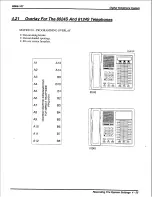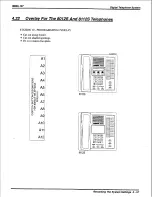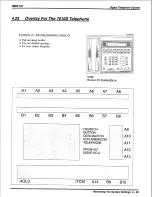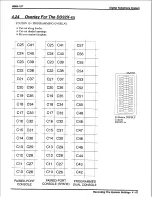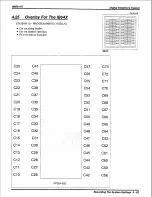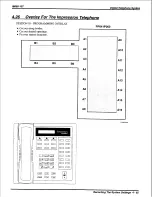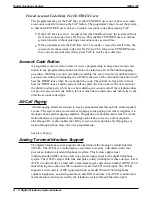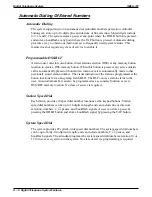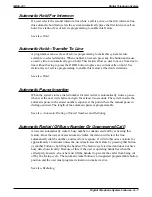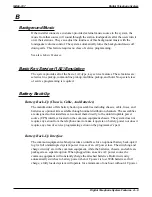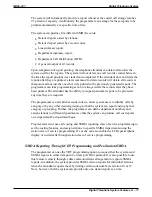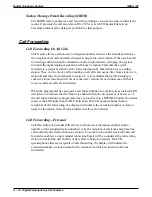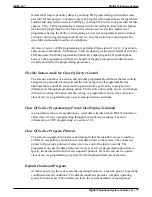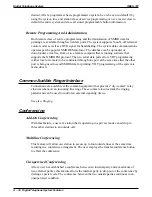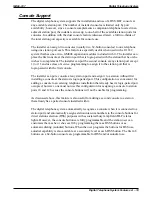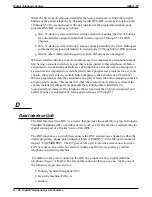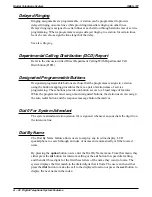
Automatic Hold For Intercom
If a user selects the second intercom line while a call is active on the first intercom line,
this automatic hold feature lets the system automatically place the first intercom call on
hold. Use station class of service programming to enable this feature.
See also, Hold.
Automatic Hold—Transfer To Line
A programmer can use class of service programming to make this system feature
available to selected stations. When enabled, a user can press any line button and cause
an active line to automatically go on hold. This feature allows a user to move from line to
line without having to press the HOLD button to place any current calls on hold. Use
station class of service programming to enable this feature at the desired stations.
See also, Hold.
Automatic Pause Insertion
When the system stores a dialed number for later redial, it automatically stores a pause
whenever the user waits between digits for at least two seconds. The system inserts the
automatic pause in the stored number sequence at the point where the manual pause in
dialing occurred. The length of the automatic pause is programmable.
See also, Automatic Dialing of Stored Numbers and Redialing.
Automatic Redial (Of Busy Number Or Unanswered Call)
A user can automatically redial a busy number or unanswered call by activating this
feature. Once the user activates automatic redial, the station will select the line,
automatically dial the number, and wait for a response. It will do this once a minute for
approximately 10 minutes unless the user deactivates the feature by pressing that button
or another button or by lifting the handset. The feature cycle is timed and does not have
busy detection circuitry. Because of this, if the user is operating handsfree when the
called party answers, she or he must lift the handset to prevent the caller from being cut
off by the timing cycle. The automatic redial button is a designated programmable button
position and the user must program its location to make it active.
See also, Redialing.
IMI66–107
Digital Telephone System
Digital Telephone System Features A – 7
Summary of Contents for Air Impact DSU
Page 2: ...Printed in U S A GCA47 157 ...
Page 30: ......
Page 112: ......
Page 192: ...Digital Telephone System IMI66 107 3 80 System Programming ...
Page 283: ......
Page 284: ......
Page 285: ......
Page 286: ......
Page 287: ......
Page 288: ......
Page 289: ......
Page 290: ......
Page 291: ......
Page 292: ......
Page 293: ......
Page 294: ......
Page 295: ......
Page 296: ......
Page 297: ......
Page 298: ......
Page 299: ......
Page 300: ......
Page 301: ......
Page 302: ......
Page 303: ......
Page 304: ......
Page 305: ......
Page 306: ......
Page 307: ......
Page 308: ......
Page 309: ......
Page 310: ......
Page 311: ......
Page 312: ......
Page 313: ......
Page 314: ......
Page 315: ......
Page 316: ......
Page 317: ......
Page 318: ......
Page 319: ......
Page 320: ......
Page 321: ......
Page 322: ......
Page 323: ......
Page 324: ......
Page 325: ......
Page 326: ......
Page 327: ......
Page 328: ......
Page 329: ......
Page 330: ......
Page 331: ......
Page 332: ......
Page 333: ......
Page 334: ......
Page 335: ......
Page 336: ......
Page 337: ......
Page 338: ......
Page 339: ......
Page 340: ......
Page 431: ......
Page 436: ......
Page 437: ......
Page 438: ......


